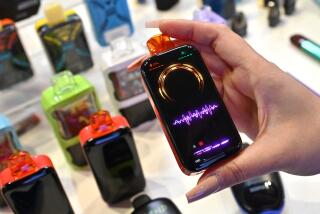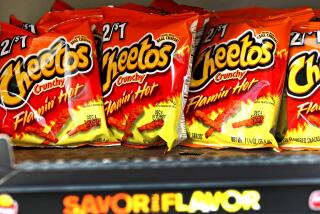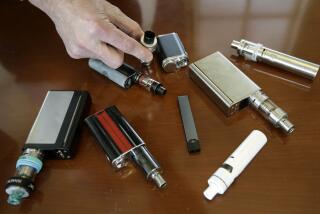CDC director explains what he hates about electronic cigarettes
Of all the threats to Americans’ health -- a list that includes bird flu, measles and West Nile virus -- few get Dr. Tom Frieden as riled up as electronic cigarettes.
As director of the Centers for Disease Control and Prevention, Frieden has a ready-made platform for spreading his views about the dangers of vaping. During a visit to the Los Angeles Times on Monday, we asked him why he is so passionate about e-cigarettes.
“I’ve treated so many adults who are desperate -- desperate -- to get off tobacco. They all started as kids,” Frieden said. “I see the industry getting another generation of our kids addicted. To me, as a physician, when 1.78 million of our high school kids have tried an e-cigarette and a lot of them are using them regularly … that’s like watching someone harm hundreds of thousands of children.”
In addition, he said, “people have a misconception that the tobacco epidemic is a thing of the past. Tobacco still kills more Americans than any other cause. It still kills more than 1,000 people a day. As a doctor, I can tell you it kills them in really unpleasant ways -- gasping for breath with emphysema, with cancer, with heart disease.”
What does that have to do with e-cigarettes?
“E-cigarettes are a tobacco product,” he said.
Actually, the battery-operated devices do not burn tobacco. Instead, as my colleague Monte Morin reported, they “heat nicotine, propylene glycol and glycerin into a vapor, which is inhaled by the user.”
[Updated at 5:46 p.m. PDT April 29: The nicotine burned in an e-cigarette may be extracted from a tobacco plant, according to the Food and Drug Administration.]
Still, Frieden rattled off five reasons why e-cigarettes are as dangerous as tobacco cigarettes:
--“If they get another generation of kids more hooked on nicotine and more likely to smoke cigarettes, that’s more harm than good,” he said.
--“If they get smokers who would have quit to keep smoking instead of quitting, more harm than good.
--“If they get ex-smokers who have been off nicotine to go back on nicotine and then back to cigarettes, more harm than good.
--“If they get people who want to quit smoking and would have taken medicines to think e-cigarettes are going to help, but they don’t, more harm than good.
--“If they re-glamorize smoking, it’s more harm than good.”
Just for good measure, Frieden threw in two more problems with e-cigarettes: People who use them can expose kids, teens and pregnant women to nicotine via secondhand smoke; and enterprising smokers can put marijuana or hallucinogens in an e-cigarette “tank.”
Frieden acknowledged that “stick to stick, they’re almost certainly less toxic than cigarettes” and that many people have quit smoking tobacco cigarettes with the help of e-cigarettes. However, he said, “the plural of anecdote is not data.”
“If the e-cigarette companies want to market these to help people quit, then do the clinical trials and apply to the FDA,” he said, in a reference to the Food and Drug Administration. “But they don’t want to do that. They want to market them widely.”
Just last week, the FDA announced it would begin regulating electronic cigarettes by forbidding sales to minors and requiring manufacturers to include health warnings on the devices. Frieden called those moves “a good first step.”
“The challenge that the FDA has is that they will be challenged by the tobacco industry, as they have been at every step of the way,” he said. The federal agency “tried to regulate e-cigarettes earlier, and they lost to the tobacco industry. … So the FDA has to balance moving quickly with moving in a way that’s going to be able to survive the tobacco industry’s highly paid legal challenge.”
If you’re interested in the latest news about science and medicine, you like the things I write about. Follow me on Twitter and “like” Los Angeles Times Science & Health on Facebook.







